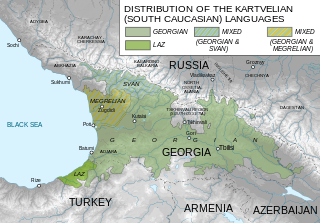Garigeba khelmts'ip'is karisa (Georgian :გარიგება ჴელმწიფის კარისა), translated into English as "Regulations of the Royal Court", "Institution of the Royal Court" or "Constitution of the Royal Court", is a medieval Georgian code of laws commonly assigned to the second reign of George V "the Brilliant" (r. 1314-1346), or to a period not far removed from it. [1] Only part of the original text has been preserved in the form of a single 17th-century manuscript. [2] It is an important document bearing on the structure of the Kingdom of Georgia and usefully supplements the account of the Georgian medieval court and state organization given by the early 18th-century scholar Prince Vakhushti in his description of Georgia. [3]

Georgian is a Kartvelian language spoken by Georgians. It is the official language of Georgia. Georgian is written in its own writing system, the Georgian script. Georgian is the literary language for all regional subgroups of Georgians, including those who speak other Kartvelian languages: Svans, Mingrelians and the Laz.

English is a West Germanic language that was first spoken in early medieval England and eventually became a global lingua franca. It is named after the Angles, one of the Germanic tribes that migrated to the area of Great Britain that later took their name, as England. Both names derive from Anglia, a peninsula in the Baltic Sea. The language is closely related to Frisian and Low Saxon, and its vocabulary has been significantly influenced by other Germanic languages, particularly Norse, and to a greater extent by Latin and French.

Georgia is a country in the Caucasus region of Eurasia. Located at the crossroads of Western Asia and Eastern Europe, it is bounded to the west by the Black Sea, to the north by Russia, to the south by Turkey and Armenia, and to the southeast by Azerbaijan. The capital and largest city is Tbilisi. Georgia covers a territory of 69,700 square kilometres (26,911 sq mi), and its 2017 population is about 3.718 million. Georgia is a unitary parliamentary republic, with the government elected through a representative democracy.
What has survived of this treatise provides a systematic and minutely elucidated picture of the court, administrative machinery and social structure of the medieval Georgian state. Some clauses of the treatise are clearly based on tradition going back to the 11th and 12th centuries. Among the most important chapters are those dealing with court etiquette, including such ceremonies as the order for the coronation service, the king’s dressing and robing, the serving of the royal dinner, audiences, and the celebration of major holidays and religious feast days. The duties and prerogatives of the ministers of state (viziers) are laid down, and the protocol for sessions of the Privy Council (savaziro) is set out. A chapter on the responsibilities of the amirspasalar (commander-in-chief) and his staff gives technical details on the equipment and armor supplied to the Georgian royal army. [3]

A vizier is a high-ranking political advisor or minister. The Abbasid caliphs gave the title wazir to a minister formerly called katib (secretary), who was at first merely a helper but afterwards became the representative and successor of the dapir of the Sassanian kings.
Amirspasalar or amirspasalari was the commander-in-chief of the medieval Georgian army and one of the highest officials of the Kingdom of Georgia, commonly rendered as "Lord High Constable" in English. It is composed of amir, an Arabic term meaning "commander", "governor", or "prince"; and sipahsalar, from the Persian for "army commander".
The document was discovered and published by Ekvtime Takaishvili, Institution des cours royales, Tiflis, 1920 (Monumenta Georgica, tom. IV, no. 1). Much of the material contained in it is translated in English and incorporated in W.E.D. Allen, A History of the Georgian People, London, 1932. Another important edition is Ivane Surguladze (ed., Tbilisi, 1993), Regulations of the Royal Crown (ხელმწიფის კარის გარიგება), which includes English translation by Ketevan Surguladze.

Ekvtime Takaishvili was a Georgian historian, archaeologist and public benefactor.

London is the capital and largest city of both England and the United Kingdom. Standing on the River Thames in the south-east of England, at the head of its 50-mile (80 km) estuary leading to the North Sea, London has been a major settlement for two millennia. Londinium was founded by the Romans. The City of London, London's ancient core − an area of just 1.12 square miles (2.9 km2) and colloquially known as the Square Mile − retains boundaries that follow closely its medieval limits. The City of Westminster is also an Inner London borough holding city status. Greater London is governed by the Mayor of London and the London Assembly.












